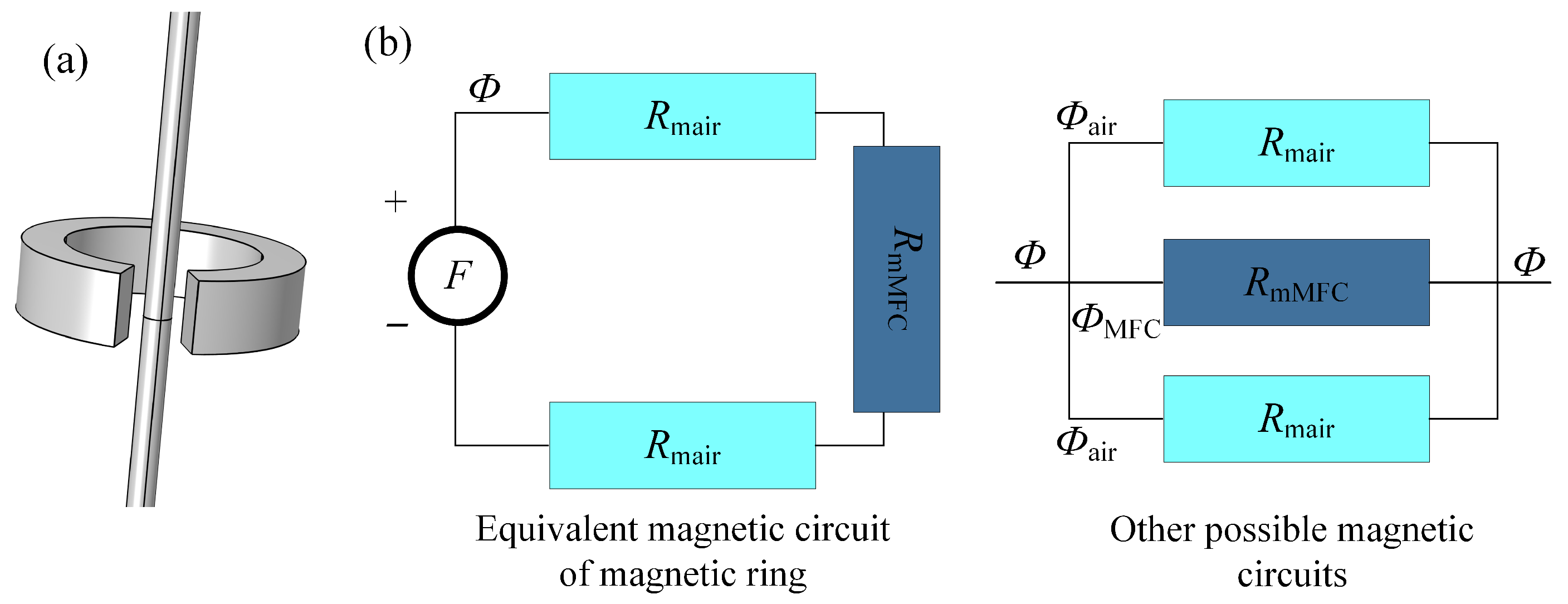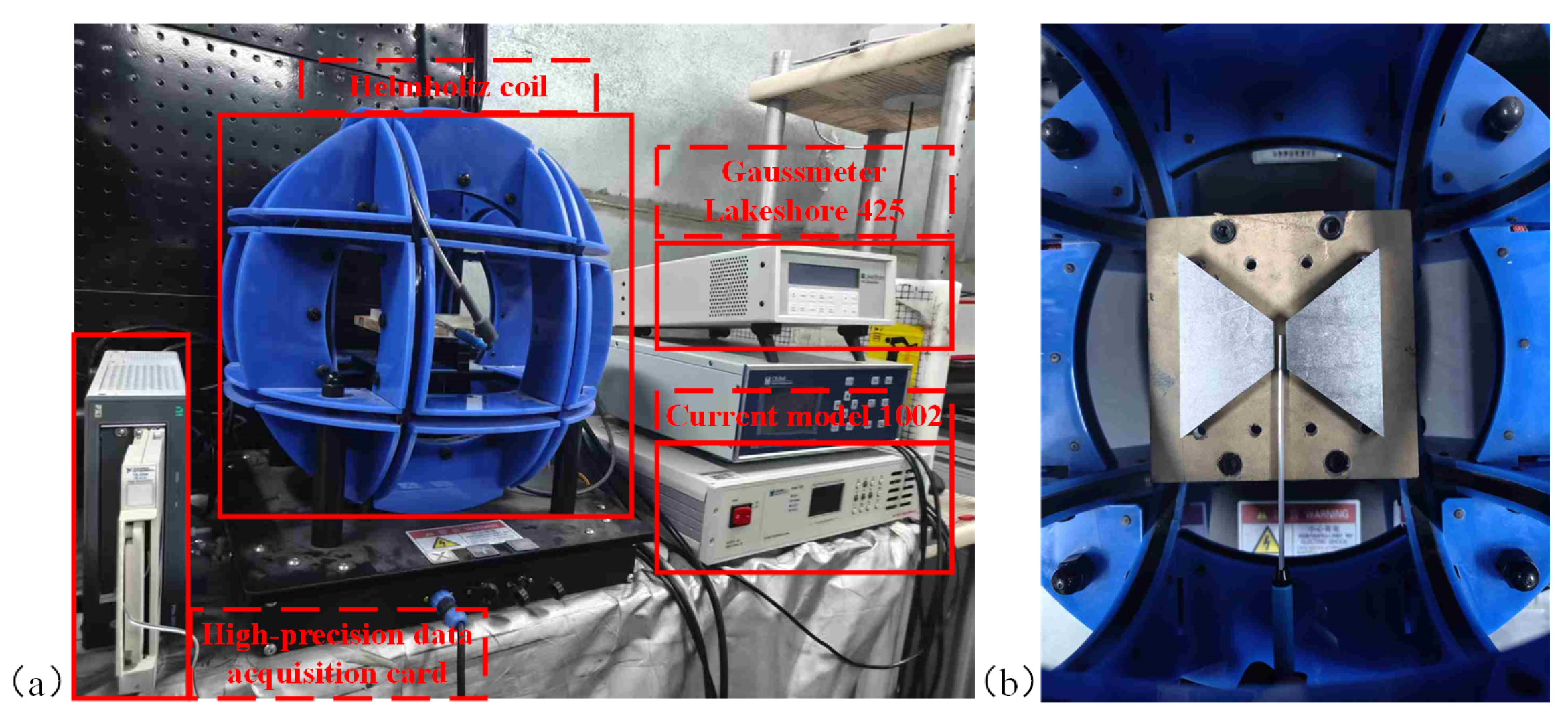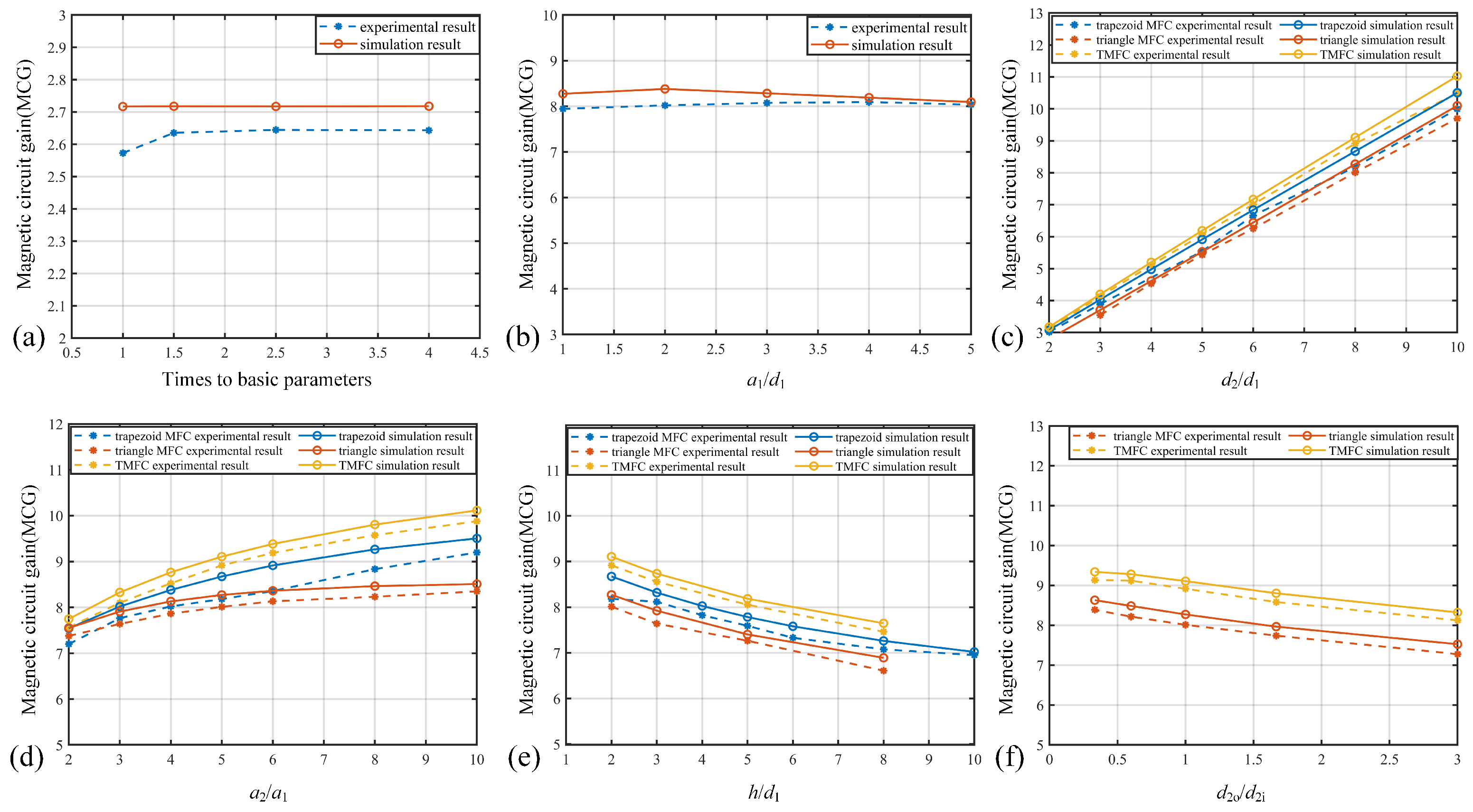The Influence of Dimensional Parameters on the Characteristics of Magnetic Flux Concentrators Used in Tunneling Magnetoresistance Devices
Abstract
1. Introduction
2. Theoretical Analysis and Simulation
2.1. Magnetic Circuit Theory Analysis
2.2. Simulation Setup
2.3. COMSOL Simulation Analysis Results
3. Experimental Methods and Discussion
3.1. Experimental Platform Construction and Experimental Design
3.2. Experimental Methods
4. Conclusions and Discussion
Author Contributions
Funding
Institutional Review Board Statement
Informed Consent Statement
Data Availability Statement
Acknowledgments
Conflicts of Interest
References
- Fujiwara, K.; Oogane, M.; Kanno, A.; Imada, M.; Jono, J.; Terauchi, T.; Okuno, T.; Aritomi, Y.; Morikawa, M.; Tsuchida, M. Magnetocardiography and magnetoencephalography measurements at room temperature using tunnel magneto-resistance sensors. Appl. Phys. Express 2018, 11, 023001. [Google Scholar] [CrossRef]
- Fang, J.C.; Wei, K.; Jiang, L.; Xiang, M.; Lu, J. Scientific facilities for ultrasensitive measurement of magnetic field and inertial rotation and prospects of zero-magnetism science. Acta Aeronaut. Astronaut. Sin. 2022, 43, 306–332. [Google Scholar]
- Yan, S.H.; Zhou, Z.T.; Yang, Y.D.; Leng, Q.; Zhao, W. Developments and applications of tunneling magnetoresistance sensors. Tsinghua Sci. Technol. 2022, 27, 443–454. [Google Scholar] [CrossRef]
- Tsunakawa, H.; Shibuya, H.; Takahashi, F.; Shimizu, H.; Matsushima, M.; Matsuoka, A.; Nakazawa, S.; Otake, H.; Iijima, Y. Lunar magnetic field observation and initial global mapping of lunar magnetic anomalies by MAP-LMAG onboard SELENE (Kaguya). Space Sci. Rev. 2010, 154, 219–251. [Google Scholar] [CrossRef]
- El-Sheimy, N.; Li, Y. Indoor navigation: State of the art and future trends. Satell. Navig. 2021, 2, 7. [Google Scholar] [CrossRef]
- Wang, M.L.; Wang, Y.; Peng, L.; Ye, C.F. Measurement of triaxial magnetocardiography using high sensitivity tunnel magnetoresistance sensor. IEEE Sens. J. 2019, 19, 9610–9615. [Google Scholar] [CrossRef]
- Bao, B.; Hua, Y.; Wang, R.D.; Li, D.C. Quantum-based magnetic field sensors for biosensing. Adv. Quantum Technol. 2023, 6, 5. [Google Scholar] [CrossRef]
- Rhodes, N.; Rea, M.; Boto, E.; Rier, L.; Shah, V.; Hill, R.M.; Osborne, J.; Doyle, C.; Holmes, N.; Coleman, S.C.; et al. Measurement of Frontal Midline Theta Oscillations using OPM-MEG. Neuroimage 2023, 271, 120024. [Google Scholar] [CrossRef]
- Goel, N.; Babuta, A.; Kumar, A.; Ganguli, S. Hall effect instruments, evolution, implications, and future prospects. Rev. Sci. Instruments 2020, 91, 7. [Google Scholar] [CrossRef]
- Fu, S.; Li, X.B.; Lin, Z.K.; Zhao, Z.B.; Cui, X.; Tang, X.L.; Wan, J. Current measurement method of multiple chips using rectangular PCB Rogowski Coils integrated in press pack IGBT device. IEEE Trans. Power Electron. 2022, 38, 96–100. [Google Scholar] [CrossRef]
- Zheng, C.; Zhu, K.; de Freitas, S.C.; Chang, J.Y.; Davies, J.E.; Eames, P.; Freitas, P.P.; Kazakova, O.; Kim, C.; Leung, C.W.; et al. Magnetoresistive Sensor Development Roadmap (Non-Recording Applications). IEEE Trans. Magn. 2019, 55, 0800130. [Google Scholar] [CrossRef]
- Han, X.F.; Zhang, Y.; Wang, Y.Z.; Huang, L.; Ma, Q.L.; Liu, H.F.; Wan, C.H.; Feng, J.F.; Yin, L.; Yu, G.Q.; et al. High-sensitivity tunnel magnetoresistance sensors based on double indirect and direct exchange coupling effect. Chin. Phys. Lett. 2021, 38, 128501. [Google Scholar] [CrossRef]
- Ouyang, Y.; He, J.L.; Hu, J.; Zhao, G.; Wang, Z.X.; Wang, S.X. Prediction and optimization of linearity of MTJ magnetic sensors based on single-domain model. IEEE Trans. Magn. 2015, 51, 4004204. [Google Scholar] [CrossRef]
- Hu, Y.J.; Huang, J.; Wang, J.N.; Li, Q.-X. Huge tunneling magnetoresistance in magnetic tunnel junction with Heusler alloy Co2MnSi electrodes. Chin. J. Chem. Phys. 2021, 34, 273–280. [Google Scholar] [CrossRef]
- Matsuda, K.; Uemura, T. Effect of defects in Heusler alloy thin films on spin-dependent tunnelling characteristics of Co2MnSi/MgO/Co2MnSi and Co2MnGe/MgO/Co2MnGe magnetic tunnel junctions. J. Phys. Condens. Matter 2010, 22, 164212. [Google Scholar]
- Oogane, M.; Fujiwara, K.; Kanno, A.; Nakano, T.; Wagatsuma, H.; Arimoto, T.; Mizukami, S.; Kumagai, S.; Matsuzaki, H.; Nakasato, N.; et al. Sub-pT magnetic field detection by tunnel magneto-resistive sensors. Appl. Phys. Express 2010, 22, 164212. [Google Scholar] [CrossRef]
- Rasly, M.; Nakatani, T.; Li, J.; Sepehri-Amin, H.; Sukegawa, H.; Sakuraba, Y. Magnetic, magnetoresistive and low-frequency noise properties of tunnel magnetoresistance sensor devices with amorphous CoFeBTa soft magnetic layers. J. Phys. D Appl. Phys. 2020, 54, 095002. [Google Scholar] [CrossRef]
- Jin, Z.; Mohd Noor Sam, M.A.I.; Oogane, M.; Ando, Y. Serial MTJ-Based TMR sensors in bridge configuration for detection of fractured steel bar in magnetic flux leakage testing. Sensors 2020, 21, 668. [Google Scholar] [CrossRef]
- Bi, R.; Chen, R.Y.; Wu, S.L.; Ma, H.Y.; Zhang, H.Q.; Liu, X.T.; He, J.L.; Hu, J. A high-sensitivity, low-noise, and low-hysteresis tunneling magnetoresistance sensor based on structural optimization of magnetic tunnel junctions. Sensors 2025, 25, 1730. [Google Scholar] [CrossRef]
- Cardoso, S.; Leitao, D.C.; Gameiro, L.; Cardoso, F.; Ferreira, R.; Paz, E.; Freitas, P.P. Magnetic tunnel junction sensors with pTesla sensitivity. Microsyst. Technol. 2014, 20, 793–802. [Google Scholar] [CrossRef]
- Han, K.H.; Frazier, A.B. Continuous magnetophoretic separation of blood cells in microdevice format. J. Appl. Phys. 2004, 96, 5797–5802. [Google Scholar] [CrossRef]
- Feng, Y.L.; Chen, J.Y.; Wu, K.; Wang, J.P. Design and fabrication of integrated magnetic field sensing system with enhanced sensitivity. J. Magn. Magn. Mater. 2020, 511, 166728. [Google Scholar] [CrossRef]
- Kanno, A.; Nakasato, N.; Oogane, M.; Fujiwara, K.; Nakano, T.; Arimoto, T.; Matsuzaki, H.; Ando, Y. Scalp attached tangential magnetoencephalography using tunnel magneto-resistive sensors. Sci. Rep. 2022, 12, 6106. [Google Scholar] [CrossRef]
- Silva, M.; Silva, J.F.; Leitao, D.C.; Cardoso, S.; Freitas, P.P. Optimization of the gap size of flux concentrators: Pushing further on low noise levels and high sensitivities in spin-valve sensors. IEEE Trans. Magn. 2019, 55, 4400605. [Google Scholar] [CrossRef]
- He, G.Y.; Zhang, Y.; Qian, L.J.; Xiao, G.; Zhang, Q.; Santamarina, J.C.; Patzek, T.W.; Zhang, X.X. PicoTesla magnetic tunneling junction sensors integrated with double staged magnetic flux concentrators. Appl. Phys. Lett. 2018, 113, 242401. [Google Scholar] [CrossRef]
- Zhang, X.M.; Bi, Y.; Chen, G.B.; Liu, J.; Li, J.; Feng, K.Q.; Lv, C.; Wang, W.J. Influence of size parameters and magnetic field intensity upon the amplification characteristics of magnetic flux concentrators. AIP Adv. 2018, 8, 125222. [Google Scholar] [CrossRef]
- Seidel, P.; Wunderlich, S.; Schmidl, F.; Linzen, S.; Schrey, F.; Schmidt, F.; Dörrer, L.; Steigmeier, C. Development and application of magnetic field sensors based on high temperature superconductors. In Superconducting and Related Oxides: Physics and Nanoengineering IV; SPIE: Bellingham, WA, USA, 2000; Volume 4058, pp. 265–276. [Google Scholar]
- Chen, S.J.; Hong, D.T.; Hsieh, P.H.; Wang, T.K. Three-axis vector magnetometer with a three-dimensional flux concentrator. Sensors 2024, 24, 1659. [Google Scholar] [CrossRef]
- Yang, Y.; Liou, S.H. Laminated magnetic film for micro magnetic flux concentrators. AIP Adv. 2021, 11, 035004. [Google Scholar] [CrossRef]
- Sun, X.; Jiang, L.J.; Pong, P.W.T. Magnetic flux concentration at micrometer scale. Microelectron. Eng. 2013, 111, 77–81. [Google Scholar] [CrossRef]
- Ouyang, Y.; He, J.L.; Hu, J.; Zhao, G.; Wang, Z.X.; Wang, S.X. Contactless current sensors based on magnetic tunnel junction for smart grid applications. IEEE Trans. Magn. 2015, 51, 4004904. [Google Scholar] [CrossRef]










Disclaimer/Publisher’s Note: The statements, opinions and data contained in all publications are solely those of the individual author(s) and contributor(s) and not of MDPI and/or the editor(s). MDPI and/or the editor(s) disclaim responsibility for any injury to people or property resulting from any ideas, methods, instructions or products referred to in the content. |
© 2025 by the authors. Licensee MDPI, Basel, Switzerland. This article is an open access article distributed under the terms and conditions of the Creative Commons Attribution (CC BY) license (https://creativecommons.org/licenses/by/4.0/).
Share and Cite
Bi, R.; Zhang, H.; Pan, S.; Liu, X.; Chen, R.; Wu, S.; Hu, J. The Influence of Dimensional Parameters on the Characteristics of Magnetic Flux Concentrators Used in Tunneling Magnetoresistance Devices. Sensors 2025, 25, 4739. https://doi.org/10.3390/s25154739
Bi R, Zhang H, Pan S, Liu X, Chen R, Wu S, Hu J. The Influence of Dimensional Parameters on the Characteristics of Magnetic Flux Concentrators Used in Tunneling Magnetoresistance Devices. Sensors. 2025; 25(15):4739. https://doi.org/10.3390/s25154739
Chicago/Turabian StyleBi, Ran, Huiquan Zhang, Shi Pan, Xinting Liu, Ruiying Chen, Shilin Wu, and Jun Hu. 2025. "The Influence of Dimensional Parameters on the Characteristics of Magnetic Flux Concentrators Used in Tunneling Magnetoresistance Devices" Sensors 25, no. 15: 4739. https://doi.org/10.3390/s25154739
APA StyleBi, R., Zhang, H., Pan, S., Liu, X., Chen, R., Wu, S., & Hu, J. (2025). The Influence of Dimensional Parameters on the Characteristics of Magnetic Flux Concentrators Used in Tunneling Magnetoresistance Devices. Sensors, 25(15), 4739. https://doi.org/10.3390/s25154739





